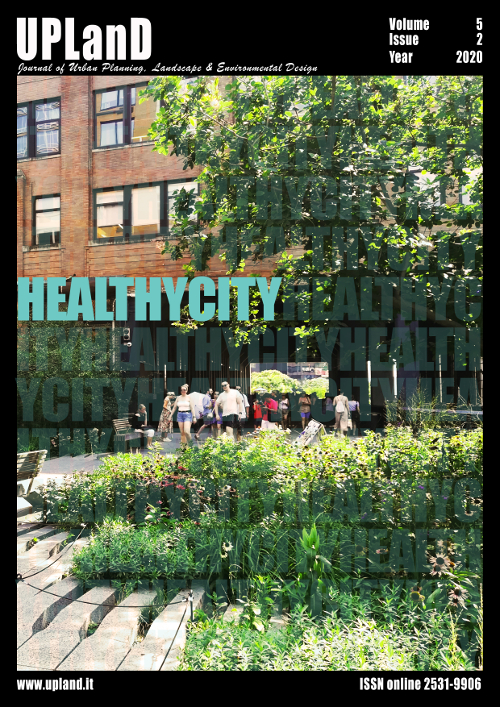A first reflection on the correlation between urban density and the spread of COVID-19 in Italy
Main Article Content
Abstract
Over 75% of the European population live in cities and towns where, therefore, the challenge of sustainability is at stake. As it is well known, sustainability has many facets, according to the Sustainable Development Goals (SDGs): one of those is the health and well-being of the population. The social and environmental costs of different patterns of urban growth have been addressed in an extensive literature. Nevertheless, the COVID-19 pandemic has undermined many established beliefs and raised new questions.
It is not yet clear whether there is a link between the spread of the virus and consequences on health and environmental conditions. So, it may be of interest to compare the different patterns of viral contamination among Italian regions and provinces, by using some indicators of population density in urban areas. Some indicators, among the many available in the literature, to assess fragmentation and compactness of settlement and population density are selected, collected and represented. In 2020 the analysis shows potentially clusters of settlement suffering over-spread of the virus in the Italian provinces.
The traditional provision of public services and spaces will have to be redefined by planners to protect and serve the population, if a potential link between the density of urban areas and the spread of the COVID-19 pandemic will be identified. That is the goal of the paper.
Downloads
Article Details

This work is licensed under a Creative Commons Attribution-NonCommercial-NoDerivatives 4.0 International License.
Authors who publish with this journal agree to the following terms:- Authors retain copyright and grant the journal right of first publication with the work simultaneously licensed under a Creative Commons Attribution License that allows others to share the work with an acknowledgement of the work's authorship and initial publication in this journal.
- Authors are able to enter into separate, additional contractual arrangements for the non-exclusive distribution of the journal's published version of the work (e.g., post it to an institutional repository or publish it in a book), with an acknowledgement of its initial publication in this journal.
- Authors are permitted and encouraged to post their work online (e.g., in institutional repositories or on their website) prior to and during the submission process, as it can lead to productive exchanges, as well as earlier and greater citation of published work (See The Effect of Open Access).
References
Barton, H., & Grant, M. (2013). Urban planning for healthy cities. Journal of Urban Health, 90(1), 129-141.
Berghauser Pont, M., & Haupt, P. (2009). Space density and urban form Technische Universiteit Delft]. Delft
Botequilha Leitao, A., & Ahern, J. (2002). Applying landscape ecological concepts and metrics in sustainable landscape planning. Landscape and Urban Planning, 59, 28. doi: 10.1016/S0169-2046(02)00005-1
Brueckner, J. K. (2000). Urban Sprawl: Diagnosis and Remedies. International Regional Science Review, 23(2), 160-171. doi: 10.1177/016001700761012710
Burton, E., Jenks, M., & Williams, K. (1996). The Compact City. A Sustainable Urban Form? Routledge.
Christiansen, P., & Loftsgarden, T. (2011). Drivers behind urban sprawl in Europe (Vol. 1136/2011). Institute of Transport Economics (TØI).
D'Onofrio, R., & Trusiani, E. (2017). Città, salute e benessere. Nuovi percorsi per l’urbanistica. Franco Angeli.
Davies, J. K., & Kelly, M. P. (1993). Healty cities. Research and practice. Routledge.
Duhl, L. J., Sanchez, A. K., & Organization, W. H. (1999). Healthy cities and the city planning process: a background document on links between health and urban planning.
EEA. (2006). Urban sprawl in Europe - The ignored challenge [Publication]. EEA.
EEA-FOEN. (2011). Landscape fragmentation in Europe. EEA. doi: 10.2800/78322
EU. (2016). Urban Europe. Statistics on cities, towns and suburbs. European Union. doi: 10.2785/91120
Gaigné, C., Riou, S., & Thisse, J.-F. (2012). Are compact cities environmentally friendly? Journal of Urban Economics, 72(2), 123-136. doi: 10.1016/j.jue.2012.04.001
Hamidi, S., & Ewing, R. (2014). A longitudinal study of changes in urban sprawl between 2000 and 2010 in the United States [Article]. Landscape and Urban Planning, 128, 72-82. doi: 10.1016/j.landurbplan.2014.04.021
Hardy, D. (2006). Cities that don’t cost the earth. TCPA.
ISPRA. (2016). Consumo di suolo, dinamiche territoriali e servizi ecosistemici - Edizione 2016 (ISPRA, Ed. Vol. 248/2016) [Pubblicazione].
Lerch, M. (2017). International migration and city growth., Population Division Technical Paper 2017/10.
Marinosci, I., Assennato, F., Luti, T., & Munafò, M. (2015). Forme di urbanizzazione e tipologie insediativa. In ISPRA (Ed.), Qualità dell’ambiente urbano – XI Rapporto (Vol. 63).
Ramaswami, A., Russell, A. G., Culligan, P. J., Sharma, K. R., & Kumar, E. (2016). Meta-principles for developing smart, sustainable, and healthy cities. Science, 352(6288), 940-943. doi: 10.1126/science.aaf7160
Schwarz, N. (2010). Urban form revisited—Selecting indicators for characterising European cities. Landscape and Urban Planning, 96(1), 29-47. doi: 10.1016/j.landurbplan.2010.01.007
Tira, M. (2020). About the Sustainability of Urban Settlements. TeMA - Journal of Land Use, Mobility and Environment, 10. doi: 10.6092/1970-9870/6984
UN. (2018). The World’s Cities in 2018 - Data Booklet. United Nations - Department of Economic and Social Affairs, Population Division.
UN. (2019). World Urbanization Prospects: The 2018 Revision (United Nations, Department of Economic and Social Affairs, Population Division ed., Vol. ST/ESA/SER.A/420). United Nations.
UNDP. (2020). COVID-19 pandemic. Humanity needs leadership and solidarity to defeat the coronavirus. https://www.undp.org/content/undp/en/home/coronavirus.html
WHO. (2020a). WHO Coronavirus Disease (COVID-19) Dashboard. https://covid19.who.int/
WHO. (2020b). World Health Statistics 2020. A visual summery. https://www.who.int/data/gho/whs-2020-visual-summary

